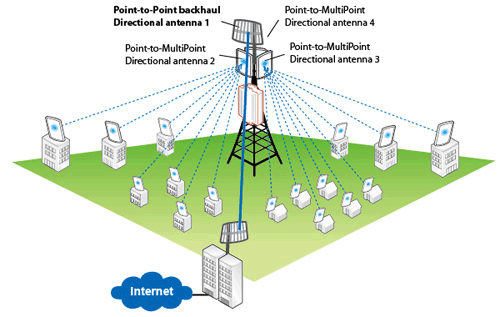

Outdoor point to multipoint wireless Ethernet bridge systems are flexible, economical, and easily deployed wireless backhaul solutions for connecting multiple remote sites to a network. Point to multipoint wireless backhaul is an ideal wireless last mile solution for interconnecting campus buildings, remote facilities, security systems, access control systems, IP video surveillance cameras, SCADA PLC’s, or WISP applications as a DSL replacement. Point to multipoint wireless can also be used to backhaul wireless mesh networks. Theycan also be used to eliminate telco dependancy or to provide wireless network redundancy.
Point to multipoint wireless Ethernet bridge systems are made up of a Base Station Unit (BSU or AP) that can communicate with multiple Subscriber Units (SU’s). Many systems can handle over 100 plus SU’s per BSU. In most cases the BSU’s provide a sector antenna beam pattern (typical is 60 degree, with some systems allowing external antenna configurations for expanding to 90 and 120 degree sector antennas). Multiple BSU’s can be installed to create a 360 degree sector (like a typical cell site configuration).
Point to multipoint wireless Ethernet bridge systems can operate in the unlicensed wireless spectrum (900MHz, 2.4Ghz, 5.3GHz, 5.4GHz, or 5.8GHz), the 3.65GHz WiMax spectrum, or in the 4.9GHz public safety band. There are propriatery point to multipoint wireless backhaul systems operated by various telecommunication providers that operate in the lincensed microwave wireless spectrums.
Point to multipoint wireless backhauls is generally used where bandwidth requirements are generally low, such as a DSL or T1 repalcement. Recently though many point to multipoint wireless systems have taken advantage of the Wi-Fi 802.11n chip sets and can now provide wireless bandwidth up to 300Mbps aggregate throughput. Note: the actual throughput at any given SU is determined by the number of SU’s connected in the system and the network configuration.
Some of the better point to multipoint wireless systems use OFDM (Orthogonal Frequency Division Multiplexing) to provide better near and non line of sight (“NLOS”) connectivity. The newer 802.11n chip set systems also take advantage of multipathing by incorporating MIMO (2×2 or 3×3) to give even better NLOS capability and higher bandwidth. The range of a point to multipoint wireless backhaul can extend as far as 10 miles with clear line of sight (“LOS”), by using high gain directional antennas connected to the SU’s. The optimum performance though of most point to multipoint wireless is in the 1 to 2 mile max range. NLOS applications need to be closer to the BSU / AP in order to have adequate system gain.
There are a lot of manufactures that offer point to multipoint wireless Ethernet bridges. Some manufactures have been in the point to multipoint wireless arena for many years. Proxim with their Tsunami MP.11 series (5054-R which is a tri-band 5.3GHz, 5.4GHz, or 5.8GHz system, MP.16 that is a 3.3GHz, 3.5GHz, or 3.65GHz licensed WiMax system, and their newer high bandwidth MP8100 series), Motorola with their Canopy wireless (their newest is their Canopy 400 series that operates in the 5.4Ghz and the PtMP320 WiMax), and others such as: Alvarion, Firetide, Trango, Solectek and BelAir. Some of the newer players include FluidMesh (which specializes in wireless video backhaul and wireless mesh), Ubiquiti,and InscapeData.
When designing a point to multipoint wireless Ethernet bridge system it is highly recommended to perform a wireless site survey and a spectrum analysis. All systems regardless of how good they are have their limitations. The biggest source of failure we come across is unrealistic expectations of performance. Any organization thinking of deploying a point to multipoint wireless system should consult a professional wireless integration company that has a lot of experience designing and performing outdoor wireless installation.